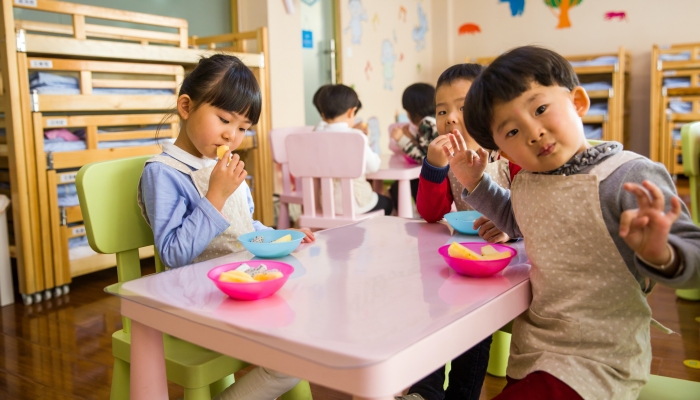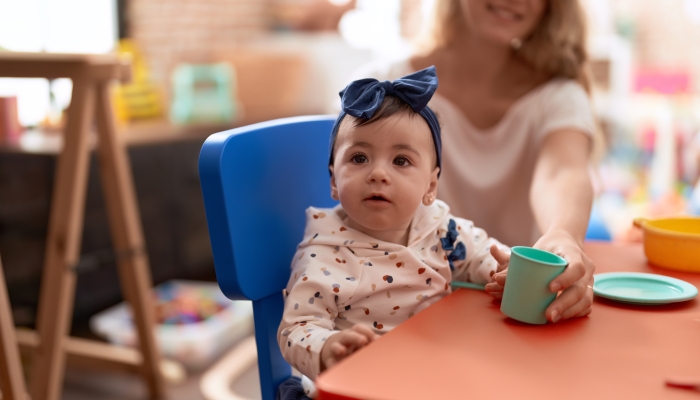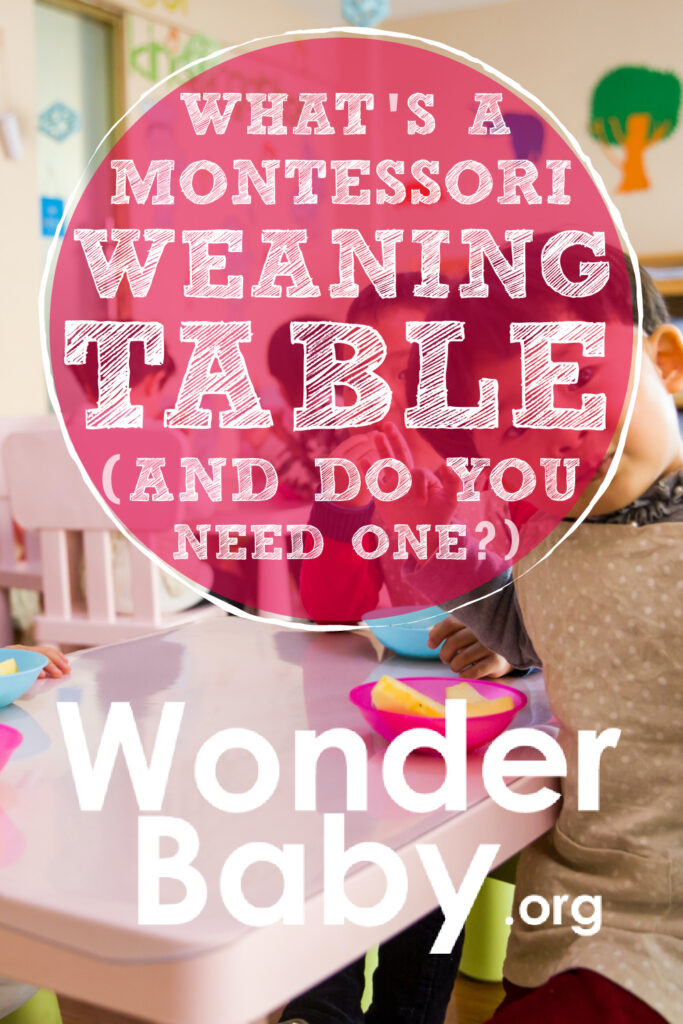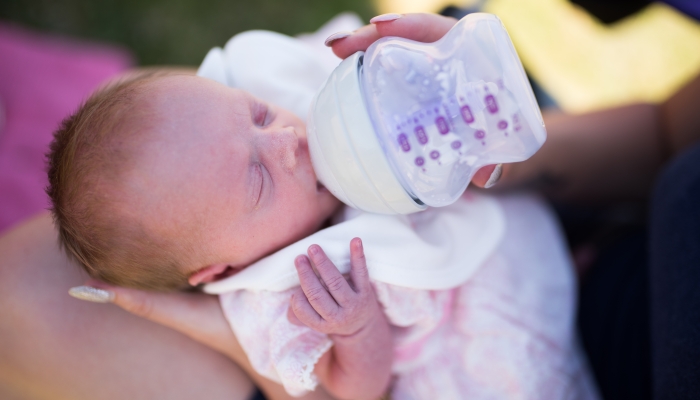What’s a Montessori Weaning Table (and Do You Need One?)

- Weaning tables and weaning chairs can help babies transition from bottle or breastfeeding to solid foods.
- Montessori weaning table sets provide many benefits, including teaching table manners and independence at mealtime and beyond.
- Babies using weaning tables should start the transition process at around nine months old.
Are you a new parent or expecting a baby soon? Or have you started introducing solids or working on baby-led weaning? You might have heard of the term “weaning table” but are unsure what it is or how it benefits your little one.
If you’re wondering whether a weaning table right for your baby, evaluate how well they’re currently transitioning from baby formula or breast milk to solid foods. If they’re gaining independence and showing interest in self-feeding, a weaning table may be the perfect solution for making the otherwise challenging change easier for everyone.
A Montessori weaning table can boost self-confidence and give your child the opportunity to learn how to eat at a bigger table. Plus, they can use the table for other activities besides eating. Read on to find out more about weaning tables and whether or not you should add one to your kitchen.
What Is a Montessori Weaning Table?
A Montessori weaning table is a small chair set that you can place near the family table or dining area that’s the perfect size for babies. You’ve likely seen them at friends’ or family members’ homes if you know someone with little kids.
Of course, they’re not for everyone, but the table could be a great way to safely transition your baby from their high chair to a big kid table and, eventually, the family table.
Before purchasing a Montessori table, take some time to understand everything there is to know about the toddler table and why it might be a good solution for your child.
What Kinds of Weaning Tables Are Available?
Some styles of the specialized table have attachments that can help babies during the weaning process. They’ll learn to use utensils and drink from a cup, encouraging independence and self-feeding more naturally, which means less stress for mom and dad!
Additionally, weaning tables are often crafted in a multipurpose way and are used for other activities, such as a work table or desk for drawing and playing. You can also fold many styles away by tucking in the table legs, which is great for saving space.
Is a Montessori Table Necessary for Weaning?
A weaning table is not necessarily a must-have item when weaning your child. However, it can be extremely helpful in transitioning from breastfeeding or bottle-feeding to more grown-up foods. Some parents find it easier than using a high chair.
If you’re having trouble figuring out a system for weaning, a weaning table provides a specific location for your child to eat and learn self-feeding skills, turning an otherwise stressful task into something fun. Sometimes investing in a weaning table can make the weaning process more convenient, fun, and achievable for you and your little one.
6 Benefits of a Weaning Table
A Montessori weaning table set offers many advantages, not only for your tot but for you as well. With how hectic meal times can be, having the right tools, equipment, and in this case, furniture, is always a big plus!
Take a peek at some of the top reasons why people love the Montessori weaning table:
- Improvements in independence and self-confidence: Weaning tables allow babies to sit up and eat with the family. It will help your child feel more independent and included with the rest of their loved ones.
- Improves overall comfort: Weaning tables are designed to be at the right height for a baby to sit comfortably while eating. This can reduce the chance of some feeding issues.
- Teaches children manners: The included attachments are used to help babies discover and learn how to use utensils. It’s a perfect way to naturally encourage good manners and table etiquette without forcing it.
- Give the kids time to spend together: Weaning tables are an excellent way for your children to spend quality time together. They will be excited about sharing their area with their big brother or sister.
- They’re used for several reasons: Many weaning tables are also put to use for other activities such as drawing, playing with toys, or even as a desk.
- Teaches children how to set the table: You can give your child their spoons, forks, and plate along with a cup and have them set up their own spot. It’s an excellent way to get them to learn a new task.
What Is the Best Age to Start Using a Weaning Table?
Knowing the ideal time to switch to a weaning chair and table can help reduce frustration for both you and your baby. You don’t want to make the change too soon, leaving your children feeling defeated if things don’t work out. But, on the other hand, you also don’t want to wait so long that they can’t fit at a child-sized table any longer.
While you know what’s best for your baby, the optimum age for moving from a high chair to a Montessori weaning table is around nine months old. However, this age doesn’t have to be explicitly followed. A better guide to go by is when your baby can easily maneuver around independently and is consuming solid foods.
Of course, this age will vary depending on your baby’s development, so if it’s a little earlier or a little later, there’s nothing to worry about.

Top 10 Tips on How to Make Your Child Sit and Eat Meals at a Weaning Table
Weaning your child from breastfeeding or bottle-feeding to solid foods can be challenging, but using a weaning table and incorporating fun toddler meal ideas will make it easier. Here are some tips on how to successfully have your child sit and eat meals at a weaning table:
- Timely introduction: Start your child at the weaning table as early as reasonable, so they get used to it.
- Make it fun for them: Fun placemats, plates, and other table settings can be bought at a fair price and add a little more to the dining experience.
- Use your imagination: Make mealtimes fun and interactive for your baby. Start them at the table with small toys, play-doh, or paper and pencil for drawing. The more they are engaged, the better the experience will be.
- Put them in charge: Allow your child to feed themselves independently, no matter how difficult it is to step in and do it yourself. Make sure to have foods and utensils that are appropriate for their age.
- Follow a set routine: Have regular meal times and try to stay as close to the schedule as possible. The process will go smoother if they know what to expect.
- Practice patience: Weaning is a process, and getting used to sitting and eating won’t happen overnight. Stay patient and encouraging.
- Remain consistent: Use the weaning table consistently and make it the only place that your child eats.
- Encourage positive behavior: Reward your little one when they sit and eat well. Praise will encourage the same behaviors later.
- Try making it interactive: Toys, books, games, and other items placed on the table make sitting at it more exciting. Have some of your child’s favorites available.
- Lead by example: Get down to your child’s level, and sit and have a meal with them. When they see you doing it, they will want to do it too!
Introducing a weaning table to your child’s meal times can make transitioning from formula or breast milk to solid foods easy. By following the tips, you can make mealtimes a pleasant experience .
Remember that weaning takes time, but with patience, consistency, and incorporating some easy baby breakfast ideas, you can help make this transition seamless.
Is Opting for a Weaning Table Better than a High Chair?
Of course, just as some benefits come with using a weaning table, there are advantages to using a high chair. However, you must make the final decision based on your child and your family.
While Montessori parents often opt for a weaning table, some families prefer having their baby in a high chair pulled up close to the adult table. This can be easier at a young age when they’re not ready to sit independently at a small table.
You might want to move to a weaning table and weaning chair if you’re ready for your baby to sit and eat with their siblings or you want them to become more independent. You can always try it for a while and see how it goes. Moving your little one back to a high chair is plausible if it doesn’t work out as you hoped.
Are Weaning Tables in Your Future?
Overall, weaning tables are typically an excellent investment for any new parent. They can make mealtime more fun and productive, helping your little ones through the process of learning to feed themselves. Weaning tables are also space-saving. So, if you’re a new or expectant parent, consider investing in a weaning table for your baby’s solid food journey.
FAQs
Should real dishes be used with a weaning table?
Yes, real dishes help children develop fine motor skills and teach them how to use real place settings. In addition, using real plates, forks, spoons, and cups can help children learn to be more mindful. However, if you decide to use real dishes, remember that suitable containers for the child’s age and abilities are essential, and supervision is vital.
Is a footrest necessary for babies eating at a weaning table?
Babies do not necessarily need a footrest, but it can be helpful. A footrest gives the baby’s feet more support, which will help them maintain a more stable position. It can also keep them from moving around excessively. Regardless, a footrest is not considered a must-have item.
Can babies be fed on the floor?
Eating on the floor is generally considered reasonably safe for a baby. However, keep in mind there are a few things to remember. First, make sure that the floor is clean and free of any small items that could harm them.
Use a clean and soft surface like a blanket or towel for your child to sit comfortably on. It is also crucial that the baby is sitting in an upright position to prevent choking or any feeding hazards.

Related Posts

Feeding and Eating, Special Needs
Feeding Therapy Approaches for Infants with Special Needs
Many children with special needs have feeding difficulties. Working with a speech therapist, being patient, and experimenting with textures can help.

Feeding and Eating
Unexpected Foods That Cause Allergen Cross-Reactivity
A variety of unexpected foods and environmental substances can trigger an allergic reaction through cross-reactivity to food proteins.

Feeding and Eating
Easing Anxiety for Families Facing Food Allergies
Ongoing physical preparations and speaking openly about anxiety can ease the transition from diagnosis to living well with a food allergy.